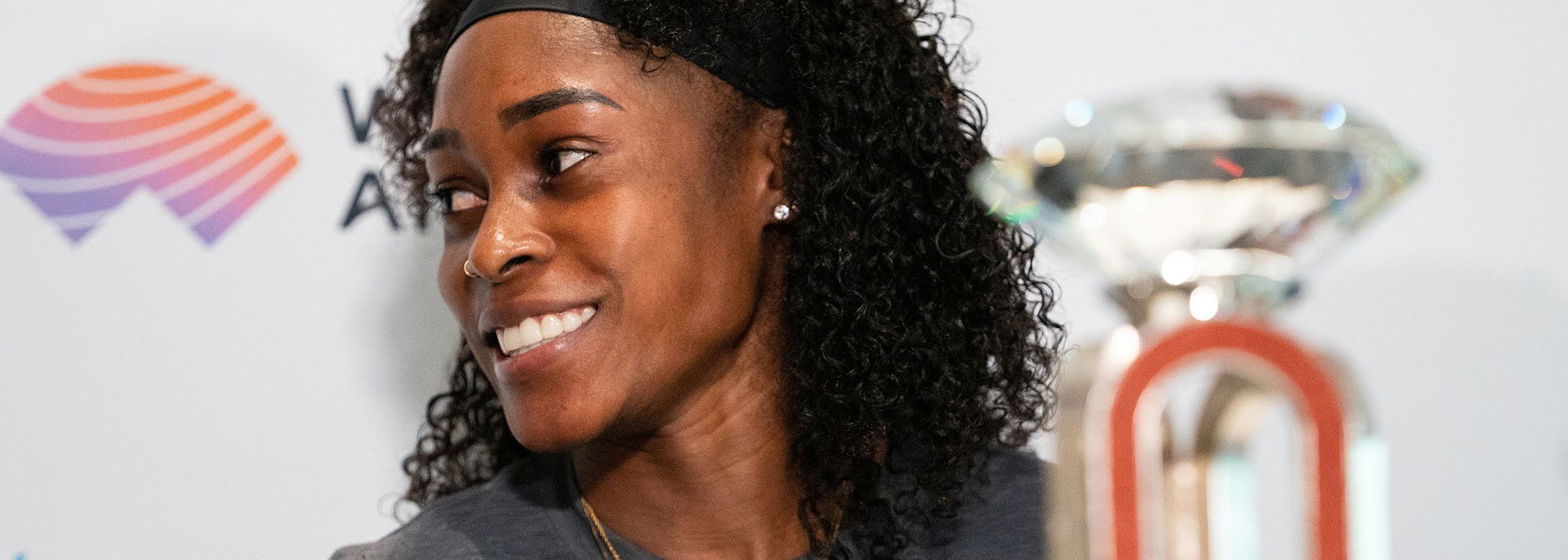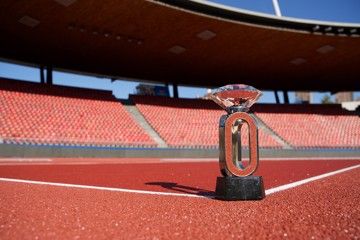Elaine Thompson-Herah at the press conference in Lausanne (© Matt Quine)
At breakfast and lunch in the athletes’ hotel on the eve of the 2021 Athletissima meeting in Lausanne on Thursday (26), the television screens were showing a continuous loop of the last edition of the celebrated Wanda Diamond League meeting to be held inside the Stade Olympique de la Pontaise.
It highlighted the quantum leap global track and field has taken since the pre-pandemic days of 2019.
Back then, Yulimar Rojas was still the second best triple jumper from South America, runner up to Caterine Ibarguen with14.82m. Mondo Duplantis was still a teenager on the up, third in the pole vault behind Piotr Lisek and Sam Kendricks with 5.81m. Jakob Ingebritsen looked equally coltish, winning the sprint for runner-up spot in the 1500m way behind the untouchable Timothy Cheruiyot. And Shelly-Ann Fraser-Pryce drew a collective gasp of awe from the capacity 13,000 crowd as she won the women’s 100m by a relative ‘street’, clocking 10.74 and finishing 0.17 ahead of Dina Asher-Smith.
Two years on, the sold-out La Pontaise is getting ready to acclaim a glittering parade of freshly crowned Olympic champions, several of whom have taken their events on to new levels.
Along the corridor from the athletes’ dining hall, at the eve of meet press conference, Rojas and Duplantis both appeared as Olympic champions and world record-holders. Ingebrigtsen did so as an Olympic champion and Olympic and European record holder. And Fraser-Pryce talked about how realistic the possibility has become of someone running a quarter of a second quicker than she did here in 2019 and finally matching, or even eclipsing, the long-standing, long deemed untouchable women’s 100m world record.
Sitting alongside the four-time world and two-time Olympic 100m champion was fellow Jamaican Elaine Thompson-Herah, fresh from the 10.54 clocking at the Diamond League meeting in Eugene last weekend (following on from her 10.61 Olympic record in Tokyo) that has put Florence Griffith-Joyner’s 33-year-old world record figures of 10.49 within reach.
“For me to run a 10.54, that makes me think it’s definitely in reach,” said the 29-year-old who has completed back-to-back Olympic 100m and 200m doubles. “It shows you that anything is possible.
“A few years ago a person came to me and said, ‘I think you can break that world record’. I said, ‘No, it’s not possible.’
“But now, after seeing what I did in Eugene, yes, I think it is possible to break a FloJo record. And I would love to do that, of course.
“I’ve watched her record races and how she ran was so easy and smooth. I try to do pretty much the same. I don’t think I’m perfect but I’m working on it.”
The 34-year-old Fraser-Pryce clocked a lifetime best of 10.63 in Kingston in June and took Olympic silver behind Thompson-Herah in Tokyo.
“As regards to running the world record, Elaine is much, much closer to that,” she said. “It’s good to be able to challenge a record that we thought for a long time was impossible.
“It speaks to the evolution of women’s sprinting, and what mechanics can do to sprinting. To be in that conversation, or to be able to be in that conversation, is truly remarkable.
“I know Lausanne has a very good track. Leroy Burrell broke the men’s world record here in 1994. I ran 10.74 in 2019, after coming straight off a plane. Hopefully the ladies here will have a superb race and we’ll see what time we can run.”
Rojas will line up in Lausanne already an outdoor world record-holder. Her stunning final-round 15.67m in Tokyo eclipsed Inessa Kravets’ 26-year-old triple jump world record by 17 centimetres. “It has been a very special season for me but I’m hungry for more,” said the 29-year-old Venezuelan, who trains in Spain under the guidance of Cuba’s four-time world long jump champion Ivan Pedroso.
“My energy level is high. It was a great result at the Olympic Games but I want to do more. I want to go better and give a show to the fans.”
It is a measure of how far Duplantis has come since 2019 that winning a gold medal in Tokyo was principally a matter of relief.
“I feel like there’s a lot less weight on my shoulders,” admitted the 21-year-old Swede. “Going into the Olympic Games, it was pretty stressful for me.
“I was the favourite. People were trying to give me the win before I even did it. That was the stressful part.
“Now that the Olympic Games is gone, I feel like I can breathe. I can feel pretty chilled.
“I can go out there and try to jump high and enjoy the competitions against my friend Sam and the others.”
Sam Kendricks beat Duplantis to World Championships gold in Doha in 2019 but the US vaulter was denied a shot at Olympic glory because of Covid protocols. “It was a tough feeling not to be able to compete at the Olympics,” he said, “but I’m here to fight the battles ahead and not the ones behind.”
For Crouser, Kendricks’ US teammate, there is a 21-final winning shot put streak to build on in Lausanne. In the past three months, the two-time Olympic champion has set a world record (23.37m), an Olympic record (23.30m) and a Diamond League record (23.15m in Eugene last Saturday) – the three longest throws in history.
“Every time I go out, I try and do the best I can to beat my personal best,” said Crouser. “The good thing is my personal best happens to be the world record.
“I don’t think about the winning streak. I knew it was getting on but I didn’t realise it was 21 now.
“I focus from competition to competition, and the people I compete against push me to be the best I can.”
No athlete did more in Tokyo to push track and field on to an elevated level than Karsten Warholm. In Lausanne, the Norwegian Superman who clocked a stratospheric 45.94 for the 400m hurdles will be testing his powers over the flat 400m.
A shot at Thomas Schoenlebe’s European record of 44.33 has been mooted. “You know my running style,” he said, when asked how he was going to approach the challenge of a different event. “I’m going to give it my all.”
But what time might we expect? “Maybe not the world record,” he replied impishly. “That’s too much to ask for.”
But the European record? “The thing about the European record is it’s been standing for a long time,” Warholm said of Schoenlebe’s winning time from the 1987 World Championships in Rome. “A lot of great 400m runners have tried to break it.
“Running the flat 400m creates a new challenge for me. I am nervous about it. I hope to do more in the future but the 400m hurdles will always be my focus.”
For Warholm’s young compatriot, Jakob Ingebrigtsen, a European record at a different event from the one in which he struck gold with a Games record in Tokyo is a more distinct possibility.
The 20-year-old Olympic 1500m champion lines up in a 3000m field featuring six medal winners from four different events in Tokyo, among them Ethiopia’s 10,000m gold medallist Selemon Barega.
Not that Ingebrigtsen would be publicly drawn on the subject of attacking Belgian Mohammed Mourhit’s continental record figures of 7:26.62.
“Yes, that’s a record,” he said when the subject was raised. “I guess we’ll see.”
Asked whether he considered the 3000m to be his best distance, the European 1500m and 5000m record-holder replied simply: “Yes.”
Barega actually lines up as the fastest in the field, having clocked 7:26.10 indoors in Lievin in February. The 2018 world indoor 3000m silver medallist was similarly coy about his prospects.
“I don’t have expectations,” said Barega. “I’m just hoping for a good race.”
Simon Turnbull for World Athletics











